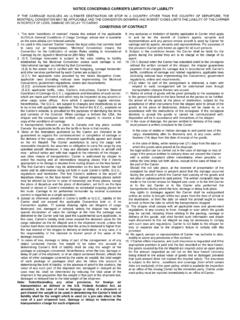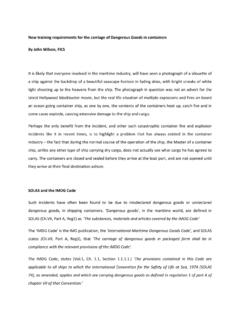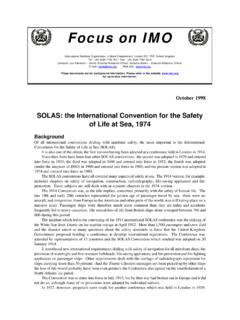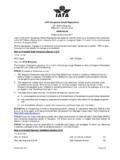Transcription of Carriage of Dangerous Goods by Road A Guide For Business
1 Carriage of Dangerous Goods by Road A Guide For Business Content Section Page 1. Introduction and definitions 2. Road transport legislation and other modes of transport The Law Other Modes of Transport 3. General safety measures and the main duty holders General safety measures Consignor Carrier Driver and vehicle crew Packer Filler Loader Tank-container/portable tank operator Unloader Consignee 4. Dangerous Goods safety advisers(DGSA). 5. Exemptions ADR exemptions Small Load (packages) exemptions National exemptions Limited quantities Excepted quantities 6. Training General awareness training and training records Driver training and examination DGSA training and examination 7.
2 Dangerous Goods classification Principles of classification Main classes of Dangerous Goods 8. Packaging, marking and hazard labelling 9. Vehicles, marking and labelling 10. Tanks ,marking and labelling 11. Bulk transport 12. Vehicle safety equipment/personal protective equipment 13. General transport provisions Loading, load restraint and unloading Mixed packing restrictions Mixed load restrictions Tunnel restrictions Parking restrictions 14. Documentation Documentation list Transport document Instructions in writing 15 Transport equipment inspection and certification 16 Security provisions 17 Emergency action 18 Record keeping 19 Enforcement Inspection Offences and penalties 20 Worked examples/common issues 21 Further information and guidance 22 Appendices: Appendix 1 Self-Assessment for the Carriage of Dangerous Goods Appendix 2 Small load exemption table ADR (max.)
3 Quantity per transport unit). Appendix 3 Instructions in writing Appendix 4 List of high consequence Dangerous Goods Appendix 5 Report on occurrences during the Carriage of Dangerous Goods Appendix 6 Vehicle Inspection Check List Appendix 7 Guidelines for the Carriage of fuel in Bowsers'. 1. Introduction and definitions This guidance is aimed at businesses that are involved in the consignment, loading/unloading and Carriage of Dangerous Goods by road. Dangerous Goods are substances and articles which have been identified as hazardous for transport and present a risk to people, property and the environment.
4 For many businesses the extent of their involvement with Dangerous Goods is limited. As the legislation provides many exemptions, particularly for such businesses and therefore reduced obligations in many cases, this Guide includes a number of worked examples in Section 20 in order to help you to quickly identify what provisions may or may not apply specifically to you. For businesses small or large that handle significant quantities of Dangerous Goods by road there is a legal obligation to appoint a Dangerous Goods safety adviser (DGSA) a competent person able to advise on the safe transport of Dangerous Goods nationally and internationally.
5 This guidance does not exclude this group, but is primarily geared towards businesses that operate below the threshold where a DGSA is legally required and therefore may not have immediate access to a DGSA. In these circumstances you may still require a DGSA from time to time and this guidance is not intended to replace that expertise. It is intended to allow you to be better informed in the decisions you make in the process of ensuring you are compliant with current legislation, and in controlling risk when handling Dangerous Goods . This Guide has been arranged to provide a comprehensive summary of the legal provisions of the ADR - European Agreement concerning the International Carriage of Dangerous Goods by Road.
6 The ADR is a technical document which provides detailed provisions specified in legislation. In instances where more detail is required, reference can be made to the ADR (ensure to reference the current edition), which is free to access and download at: In order to understand the level of activity at which you may be required by law to appoint a DGSA, the HSA has produced guidance which explains this aspect specifically, available for down-load free on the HSA website: Health and Safety Authority - ADR. Landing Page Whether or not your company requires the services of a DGSA, if your Business activities include the Carriage , loading/unloading or consignment of any quantity of Dangerous Goods , it is recommended that you use the table in Appendix 1 to assess your activities.
7 Such self-assessment will assist you in monitoring compliance with the legislation, and will give you greater confidence in your efforts to control risk. Where further advice, explanation or guidance is necessary you may contact the Health and Safety Authority or a DGSA. Definitions Terms used in this guidance have the same meaning as they have in ADR and current national legislation concerning the Carriage of Dangerous Goods by road. In this guidance: o ADR means the European Agreement concerning the International Carriage of Dangerous Goods by Road (detailed provisions re-issued every two years by the United Nations Economic Commission for Europe).
8 O DGSA means Dangerous Goods Safety Adviser (road). o HSA means the Health and Safety Authority o IMDG Code is the International Maritime Dangerous Goods Code o ICAO is the Irish Civil Aviation Authority o RID means the regulations concerning the international Carriage of Dangerous Goods by rail o MEGC is a multiple-element gas container o MEMU is a mobile explosives manufacturing unit o NRA is the National Roads Authority o Participant means any person or enterprise involved in the Carriage of Dangerous Goods by road including any person involved in the activity of loading, unloading, packing and filling and includes consignor, carrier.
9 Consignee, driver, vehicle crew, DGSA or any person with a duty under the regulations o Placard a placard is the term used to describe large hazard labels when used on vehicles/tanks o Tank means a shell including its service and structural equipment. When used alone the term tank means tank container, portable tank, demountable tank, fixed tank and tanks forming elements of a battery- vehicle or MEGC. o Transport equipment includes vehicles, tanks, tank containers, portable tanks, demountable tanks, tank swap bodies, tube trailers, bulk containers, intermediate bulk containers, containers, packaging, packages, receptacles and aerosols and any other item used or intended for use in the Carriage of Dangerous Goods by road.
10 2. Road transport legislation and other modes of transport The Law Legislation governing the Carriage of Dangerous Goods by road, nationally, throughout Europe and adopted by 46 countries worldwide, is based on the ADR. This agreement has been in place for over 50 years, and is amended every two years. In Ireland the ADR is given effect by national legislation which is frequently amended to keep in line with each edition of the ADR. Current regulations can be obtained from the HSA ADR web pages (link provided in Section 21). National legislation provides for general participant duties and the practical safe transport of Dangerous Goods , competent authorities, powers of enforcement, offences and penalties.







